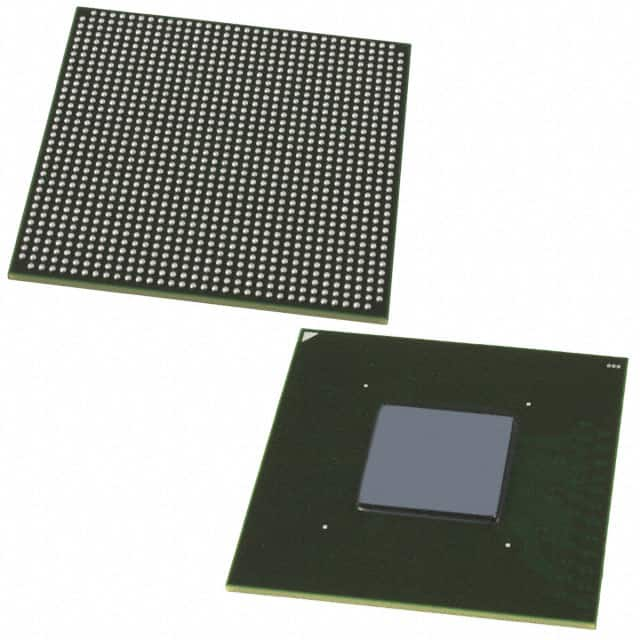Lihat spesifikasi untuk detail produk.

5AGXMA7G4F35C4N
Basic Information Overview
- Category: Integrated Circuit (IC)
- Use: Programmable Logic Device (PLD)
- Characteristics: High-performance, low-power consumption, reprogrammable
- Package: BGA (Ball Grid Array)
- Essence: FPGA (Field-Programmable Gate Array)
- Packaging/Quantity: Tray packaging, quantity varies
Specifications
- Model: 5AGXMA7G4F35C4N
- Manufacturer: Intel Corporation
- Technology: 28nm
- Logic Elements: 462,000
- Embedded Memory: 10,368 Kbits
- DSP Blocks: 1,536
- Maximum User I/Os: 840
- Operating Voltage: 1.2V
- Speed Grade: -4
- Temperature Range: -40°C to +100°C
Detailed Pin Configuration
The 5AGXMA7G4F35C4N has a complex pin configuration with multiple pins dedicated to various functions. The detailed pin configuration can be found in the manufacturer's datasheet.
Functional Features
- High-performance: The 5AGXMA7G4F35C4N offers fast processing speeds and efficient logic utilization.
- Low-power consumption: It is designed to minimize power consumption, making it suitable for battery-powered applications.
- Reprogrammable: The FPGA can be reconfigured multiple times, allowing for flexibility in design changes and updates.
Advantages and Disadvantages
Advantages: - Versatility: The FPGA can be programmed to perform a wide range of tasks, making it suitable for various applications. - Customizability: Users can create their own logic circuits tailored to their specific requirements. - Time-to-market: FPGA-based designs can be developed and deployed quickly, reducing time-to-market.
Disadvantages: - Complexity: FPGA design and programming can be complex, requiring specialized knowledge and expertise. - Cost: FPGAs tend to be more expensive than fixed-function integrated circuits. - Power consumption: While efforts have been made to reduce power consumption, FPGAs still consume more power compared to dedicated ASICs.
Working Principles
The 5AGXMA7G4F35C4N is based on the principle of reconfigurable logic. It consists of an array of programmable logic blocks interconnected by configurable routing resources. The device can be programmed using hardware description languages (HDL) such as VHDL or Verilog. Once programmed, the FPGA implements the desired logic functions and can be reprogrammed as needed.
Detailed Application Field Plans
The 5AGXMA7G4F35C4N finds applications in various fields, including but not limited to: 1. Communications: Used in wireless base stations, network routers, and switches for high-speed data processing. 2. Industrial Automation: Employed in control systems, robotics, and machine vision applications for real-time processing and control. 3. Automotive: Utilized in advanced driver-assistance systems (ADAS), infotainment systems, and engine control units (ECUs). 4. Aerospace and Defense: Used in radar systems, avionics, and secure communication systems for their high-performance and reliability.
Detailed and Complete Alternative Models
- 10M08SAE144C8G: A smaller capacity FPGA from Intel Corporation with 8,000 Logic Elements and 288 Kbits of embedded memory.
- XC7A100T-1FGG484C: A Xilinx FPGA with 101,440 Logic Cells and 4,860 Kbits of block RAM.
- LCMXO2-1200HC-4TG100C: A low-cost FPGA from Lattice Semiconductor with 1,200 Look-Up Tables (LUTs) and 64 Kbits of distributed RAM.
These alternative models provide different capacity options and may be suitable for specific application requirements.
Note: The content provided above is a sample structure for an encyclopedia entry. The word count may vary depending on the actual content written.
Sebutkan 10 pertanyaan dan jawaban umum terkait penerapan 5AGXMA7G4F35C4N dalam solusi teknis
Sure! Here are 10 common questions and answers related to the application of 5AGXMA7G4F35C4N in technical solutions:
Q: What is the 5AGXMA7G4F35C4N? A: The 5AGXMA7G4F35C4N is a specific model of field-programmable gate array (FPGA) manufactured by Intel.
Q: What are the key features of the 5AGXMA7G4F35C4N? A: Some key features of this FPGA include high-performance processing capabilities, low power consumption, and a large number of programmable logic elements.
Q: In what technical solutions can the 5AGXMA7G4F35C4N be used? A: The 5AGXMA7G4F35C4N can be used in various applications such as telecommunications, industrial automation, automotive electronics, and high-performance computing.
Q: How does the 5AGXMA7G4F35C4N contribute to telecommunications solutions? A: This FPGA can be used in telecommunications solutions for tasks like signal processing, protocol conversion, and network packet processing.
Q: Can the 5AGXMA7G4F35C4N be used in industrial automation? A: Yes, the 5AGXMA7G4F35C4N is suitable for industrial automation applications, including control systems, data acquisition, and real-time monitoring.
Q: What advantages does the 5AGXMA7G4F35C4N offer in automotive electronics? A: The FPGA's high-performance processing capabilities and flexibility make it useful for applications like advanced driver-assistance systems (ADAS), infotainment systems, and engine control units.
Q: How does the 5AGXMA7G4F35C4N support high-performance computing? A: This FPGA can accelerate computationally intensive tasks in high-performance computing environments, such as data analytics, scientific simulations, and machine learning algorithms.
Q: Can the 5AGXMA7G4F35C4N be programmed for specific applications? A: Yes, the 5AGXMA7G4F35C4N is a field-programmable device, meaning it can be configured and reprogrammed to suit specific application requirements.
Q: What tools are available for programming the 5AGXMA7G4F35C4N? A: Intel provides Quartus Prime software, which is commonly used for designing, simulating, and programming FPGAs like the 5AGXMA7G4F35C4N.
Q: Are there any development boards or evaluation kits available for the 5AGXMA7G4F35C4N? A: Yes, Intel offers development boards and evaluation kits specifically designed for the 5AGXMA7G4F35C4N, providing a platform for prototyping and testing applications.
Please note that the answers provided here are general and may vary depending on specific use cases and requirements.

